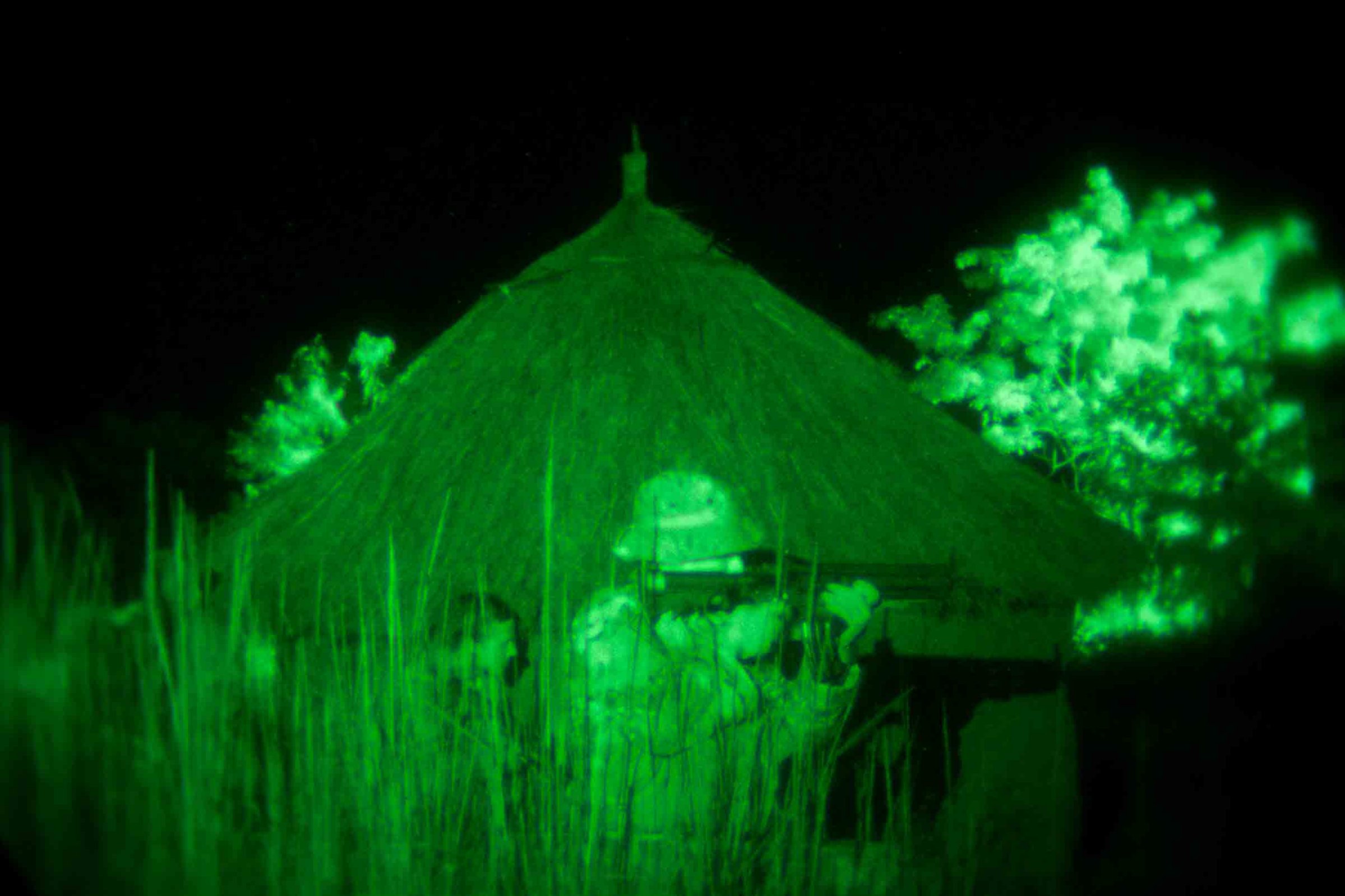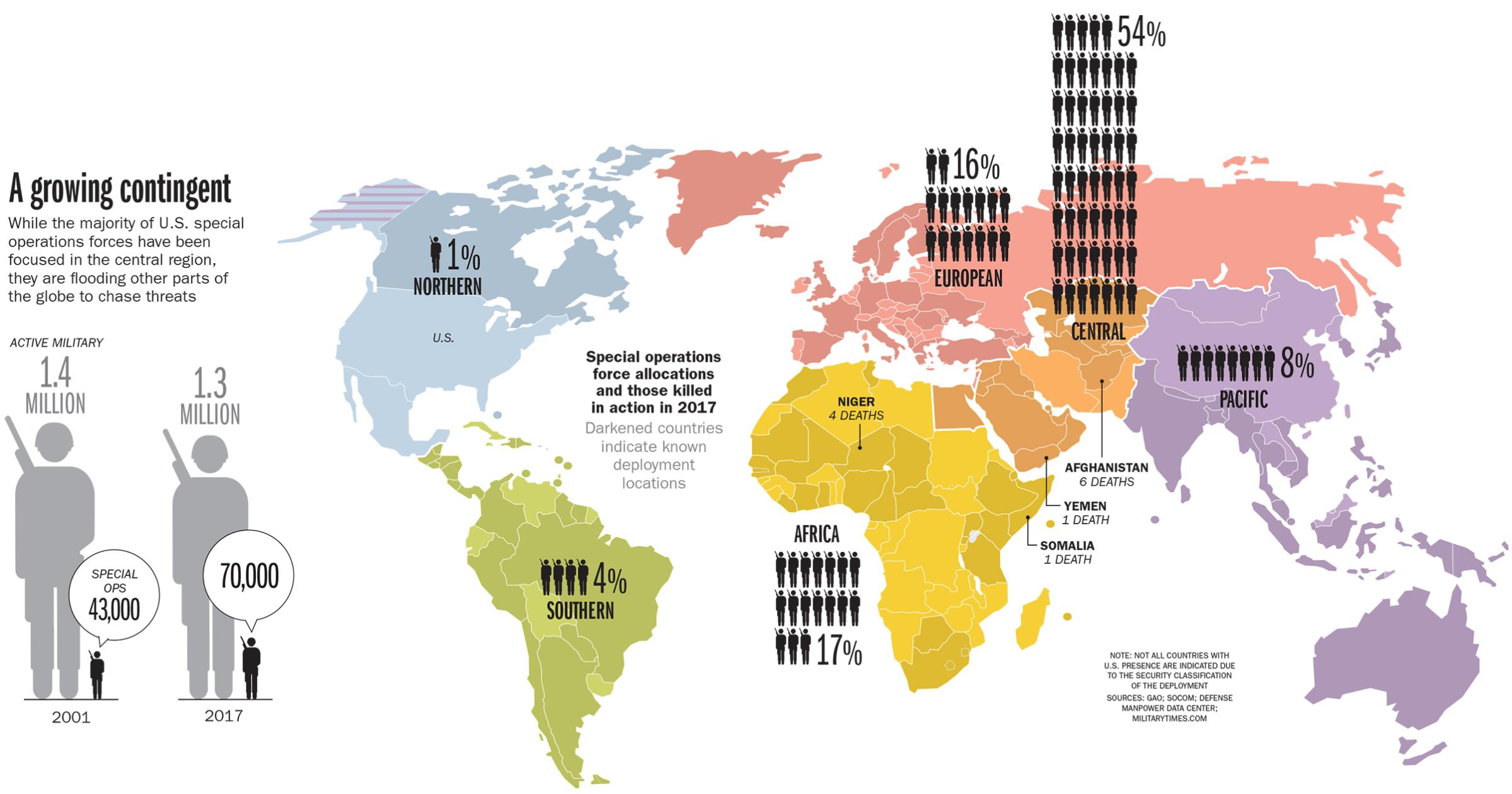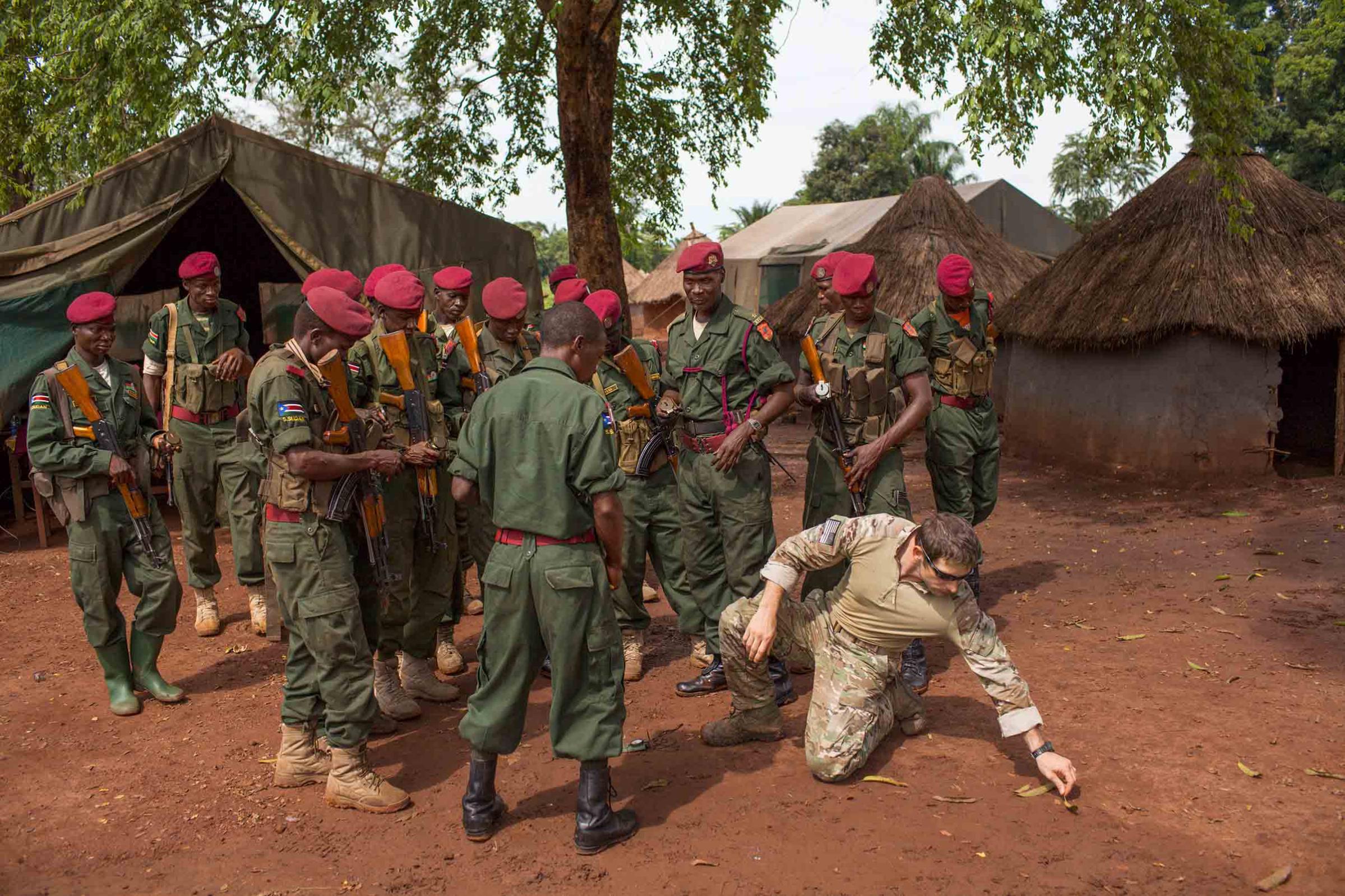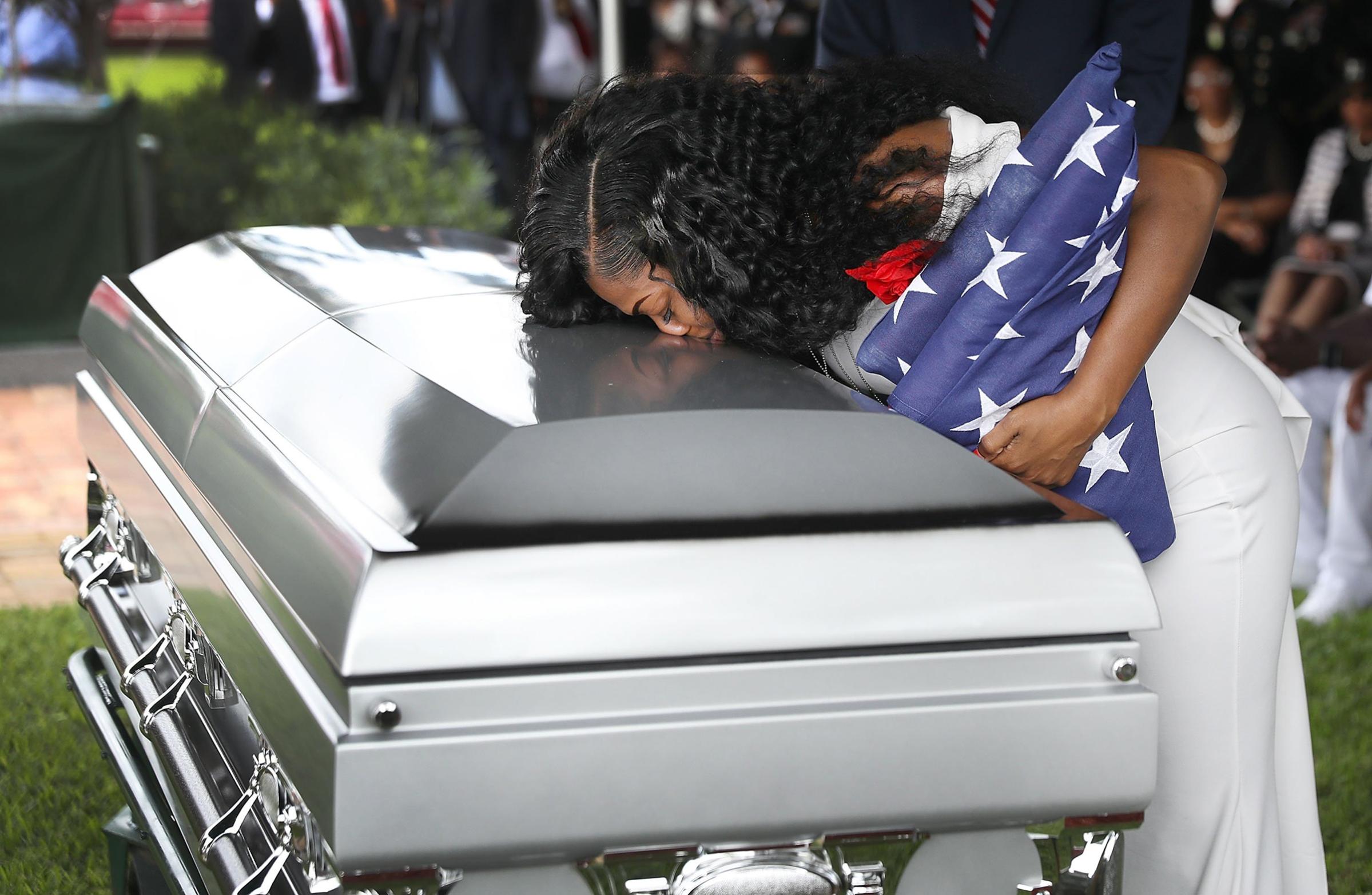
The convoy of weather-beaten trucks and Toyota Land Cruisers kicked up dirt as it streaked across the wooded West African terrain toward the hazy horizon. A joint team of 12 U.S. Army Special Forces and 30 Nigerien troops were making the trek back to base after a two-day reconnaissance mission to a remote area along Niger’s border with Mali.
The weary commandos had just spoken to elders near the village of Tongo Tongo after sifting through a deserted campsite, seeking intelligence on an elusive terrorist operative. But it was a dry hole; whoever was there had since moved along. As the mid-morning sun bore down, the commandos settled in for the 110-mile drive.
Then gunfire erupted. About 50 militants on motorcycles and in trucks swarmed the convoy, pinning it down. Unable to advance or retreat–to “get off the X” in military parlance–the Special Forces took incoming fire from rocket-propelled grenades and mortars. Over two hours of fighting led to the deaths of four U.S. soldiers.
When news of the Oct. 4 ambush broke, the reaction in Washington was shocked surprise. What were Special Forces doing in Niger in the first place? And why did the U.S. military have a dozen of its most elite, highly trained soldiers in a country that most Americans couldn’t find on a map and where the U.S. is not known to be at war?
As details emerged, the embarrassment of ignorance spread. The target of the operation, Ibrahim Dondou Chefou, code-named “Naylor Road” by U.S. intelligence, had been present days earlier at a high-level meeting of regional leaders of the Islamic State in the Greater Sahara, according to intelligence and military sources who shared details of the operation with TIME. But the question was how a supposedly low-risk mission to search his abandoned campsite had resulted in the deaths of four service members. On Capitol Hill, Senate minority leader Chuck Schumer of New York and national-security hawk Lindsey Graham of South Carolina openly admitted that they did not know about the deployment to Niger, let alone that it had grown in recent years to 800 U.S. troops. Nor did it appear fully supported: no U.S. military aircraft was available to transport the service members from the scene of the ambush to their base in the Nigerien capital of Niamey. Instead, the Pentagon relied on French helicopters and a San Marcos, Texas–based contractor, Berry Aviation, military sources tell TIME. Many Americans learned of the incident only after President Donald Trump’s public feud with the widow of one of the killed soldiers.
The little noticed buildup in Niger is just a snapshot of the expanding worldwide deployment of U.S. commandos. At any given moment, 8,000 of the country’s most elite forces, including Navy SEALs, Army Delta Force, Army Special Forces and others, are operating around the globe. In 2001, that number was 2,900. So far in 2017, the service members have deployed to 143 countries, or nearly three-quarters of the nations in the world, according to data provided by U.S. Special Operations Command, which runs the units.
Name a country in the world’s most volatile regions and it is likely that Special Operations forces are deployed there. In Iraq, Afghanistan, Syria and elsewhere, special operators are launching kill-or-capture raids against known terrorists. In the war-ravaged Middle East, commandos are training Egyptian and Saudi troops in how to fight insurgencies. At frigid bases inside former Soviet-bloc nations, they are countering Russian influence operations. In South Korea, they have added forces to help the military draw up counterstrike plans for an assault by the North Korean army. Trump has been aggressive in his use of commandos, authorizing terrorist-hunting night raids since his first days in office, and has loosened constraints on everyone from top generals to field commanders.
Over the past 16 years, Special Operations have become the new American way of war. Once mainly used to supplement the work of conventional troops, the elite units are now the go-to option for policymakers looking to manage a complicated world. More than just hunter-killers, the U.S.’s best-trained commandos are increasingly military trainers, nation builders and diplomats. With typical dark humor, members of the Special Operations community joke that they’ve become an “easy button” for successive Administrations to push–an alternative to sending thousands of conventional military forces to hot spots and risking the political blowback that comes with it.

Just because special operators are an easy option doesn’t mean their use is cost-free. The presence of U.S. troops in an unstable country can attract those who want to kill Americans and serve as a recruiting tool, experts say. Oversight of those troops is limited by the fact that the public, and many in Congress, often aren’t aware of the sometimes-classified missions. Most important, it’s not clear how the deployments fit together in a broader plan to advance U.S. national security. “There is a leadership problem,” says Army Brigadier General Donald Bolduc, who commanded all Special Operations forces in Africa until last June, “because there’s no overarching strategy.”
The nonstop deployments are taking a heavy toll on the nation’s toughest warriors, raising high-level concerns that the Special Operations forces are being stretched too thin. The 11 special operators killed in action this year, for instance, died on missions in four countries. It’s the first time commandos have died in that many countries in one year since Special Operations Command was established in 1987. Ceaseless deployment cycles have caused problems at home, driving the Pentagon to create a task force to address drug and alcohol abuse, family crises and suicide among the ranks. The ops tempo also raises the chances of battlefield mistakes, or worse. The Pentagon has at least one open investigation into civilian deaths involving U.S. special operators in Somalia, and another into the alleged murder of a Green Beret at the hands of two Navy SEALs.
If the other options are large conventional troop deployments or a retreat into isolation, experts say, the expanded reliance on special ops may be necessary. But in May, General Raymond Thomas, commander of Special Operations Command, told Congress that the rate of deployments was “unsustainable.” Michael Repass, a retired major general who headed Special Operations Command in Europe, is more blunt. “We’re not frayed at the edges–we’re ripped at the damn seams,” he says. “We have burned through this force.”
The reliance on Special Operations was born of necessity. The Sept. 11, 2001, attacks by al-Qaeda showed that tanks, aircraft carriers and the deployment of battalions of tens of thousands of conventional forces could no longer protect the U.S. as they had during the Cold War. Congress authorized the President to go after al-Qaeda anywhere and everywhere, turning the world into a battlefield and commandos into the go-to force against a new stateless threat. Often proficient in the languages of their host countries, and trained to be both lethal and smart, they could deploy to root out terrorists among civilian populations.
At first the strategy worked. The Green Berets of Special Forces 5th Group toppled the Taliban in eight weeks, riding into battle atop horses with Afghanistan’s Northern Alliance. Then the Pentagon turned with renewed focus to al-Qaeda. On Jan. 4, 2002, Special Forces Sergeant First Class Scott Neil jumped out the back of an MH-53 helicopter half a mile from a suspected al-Qaeda compound that was 140 miles south of the Afghan capital of Kabul. With just one hour of on-scene time, thanks to limited helicopter fuel, Neil managed to rush through incoming AK-47 fire; calm a terrified, screaming girl with a Baby Ruth candy bar he had in his pocket; and overcome his al-Qaeda adversaries. The reward was a trove of intelligence from what turned out to be an al-Qaeda way station: hundreds of fake passports to give terrorist recruits new identities, and multiple computers, powered by car batteries and linked to satellite phones for Internet connection. Such intelligence coups led to more targets, more targets led to more raids, and more raids led to more intelligence in a never-ending domino effect.
Then President George W. Bush changed the subject to Iraq, and Neil and his compatriots were in Kuwait helping to lay the groundwork for the March 2003 invasion. After a break at home in May 2003, he deployed in August to the African nation of Djibouti to conduct raids on cells of foreign fighters elsewhere in the Middle East. Back home again in February 2004, he left for Iraq again that August. “It went on like that for years,” Neil says now, “It was nonstop running and gunning.”
When President Barack Obama took office, he promised to end two U.S. ground wars. But again, that meant more work for commandos. Obama cut the number of conventional troops in war zones from 150,000 to 14,000 over his eight years in office. But Special Operations forces never went home: they stayed in Iraq and Afghanistan, or went elsewhere. Obama had shifted the burden of the fight against the insurgencies to commandos. He boosted Special Operations Command’s annual budget from $9.3 billion to $10.4 billion and added more than 15,000 personnel.
The expansion has continued under Trump. One of the first moves the Republican made in office was to loosen the reins on the operations that commandos could purse in Yemen. In his first week, he authorized a raid on an al-Qaeda compound in the country, but the predawn operation with forces from the United Arab Emirates went bad. The militants were prepared and took up arms, and the SEALs had to fight their way out. Navy SEAL Chief Special Warfare Operator William “Ryan” Owens, 36, died. Three other service members were injured in the raid. More than a dozen civilians were killed as well. Two months later, Trump signed off on an aggressive campaign against al-Shabab militants in Somalia, in East Africa. Navy SEAL Senior Chief Special Warfare Operator Kyle Milliken, 38, was killed and two other SEALs were wounded in a May 5 raid.
Special Operations forces now make up nearly all U.S. combat casualties, despite making up less than 5% of the total force. Commandos died in greater numbers than conventional forces for the first time in 2016. And again in 2017.
Milliken was killed as part of a so-called “train, advise and assist” mission. To fully appreciate the dangerous overextension of the nation’s Special Operations forces, you have to know that what are being billed as training missions are often indistinguishable from traditional combat. “It’s easier to put ‘trainers’ and ‘advisers’ in a country and say we don’t have ‘boots on the ground,'” says former Navy SEAL Scott Taylor, who is now a GOP Congressman from Virginia. “Well, that’s bullshit. They’re combat boots, every one of them.”

It is in that euphemistic role that the real growth in elite deployments around the world has come. The most widespread units of Special Operations deployment are 12-man Operational Detachment Alpha teams, or A-teams. All undergo a year to two years of selection, assessment and training at Fort Bragg to develop basic physical, academic and tactical skills. A-teams are further trained according to their projected mission, learning the customs and languages of the locals in the countries and regions where they expect to deploy. And they get specialized skills: some train to help with local medical problems. Others have learned how to do animal husbandry in communities that rely on livestock. Still others have become experts in agricultural work as part of the command’s drug-control missions.
But nation building and diplomatic outreach often bleed over into firefights with armed enemies, the type of missions for which every special operator is trained. Many commandos live and work with units fighting insurgencies allied with U.S. enemies in unstable countries. In the past, much of the training took place on bases. Increasingly, commandos are going outside the wire to help conduct raids that rely on intelligence gathered by foreign allies.
Africa in particular has seen a dramatic expansion of the Special Operations presence. Over the past year, the Pentagon has moved more than 15% of its Special Operations forces to assist relatively small, poorly equipped African militaries, up from 1% in 2006. Where a decade ago the U.S. had special operators sporadically deployed on the continent, it now has 1,200 dedicated to about a dozen countries there.
The expanding global deployments, violent or otherwise, can be successful, if underappreciated. In Colombia, special operators helped defeat the decades-long FARC insurgency that had turned the country into a near failed state and a source of much of the world’s cocaine trade. In the Philippines, commandos helped suppress a long-running Islamist insurgency. Last summer, commandos were dispatched to the Syrian city of Tal Abyad, near the Turkish border, to resolve dangerous, mounting tensions between Turkish and Kurdish forces–sworn enemies that are both U.S. allies in the fight against ISIS. In Iraq and Afghanistan, commandos trained the two fighting units that have consistently stood their ground, and won, against Islamist insurgents.
All the while demands increase, especially in Africa, where al-Qaeda and ISIS, under pressure in the Middle East and South Asia, are expanding. “It’s like squeezing a balloon,” says Stuart Bradin, a retired Special Forces colonel. “The pressure has been applied to the bad guys in one area of the world, so they run somewhere else.” The current tempo varies, but special operators usually deploy for six months at a time, with six months at home. Special Operations Command’s long-stated goal is to improve the ratio to 12 months off for every half-year in theater. “The guys just want some predictability,” says Richard Lamb, a retired Army command sergeant major who spent nearly four decades as a soldier and civilian in the Special Forces community.
Defense Secretary James Mattis acknowledged the stresses and said the military is looking for solutions. One is to off-load some of the burden to more lightly trained conventional forces. This year, the Army created the Security Force Assistance Brigades, designed to provide services to foreign militaries similar to those special operators now provide. The units have no junior enlisted soldiers and will rely heavily on experienced non-commissioned officers. They attend a recently established school at Fort Benning, and the first units will be deployed to Afghanistan early next year.
But widespread foreign-forces training can come with considerable costs. Andrea Prasow, deputy Washington director at Human Rights Watch, says the U.S. military has trained war criminals in Afghanistan and elsewhere because on balance it was better to have them as allies. “That probably has some security benefits,” Prasow says, “but it also carries security risks,” as it can stir up anti-American resentment among civilians. Covert night raids and drone strikes have inadvertently killed thousands of civilians across several countries, risking another domino effect by inspiring a new generation of militants.
The U.S. Government Accountability Office, Congress’s watchdog, has warned that while the Special Operations forces have grown in size, their missions have grown faster. The author of an alarming 2015 GAO study, John Pendleton, warns that overuse will be catastrophic. Pendleton likens the situation to the failings he flagged that led to two Navy collisions this year in the Pacific Ocean, which killed 17 sailors. “Ultimately, multiple tragedies occurred,” he says. “Special Operations Command’s situation sounds eerily familiar.”

U.S. Army Command Sgt. Maj. Chris Faris’ daughter stood in his bedroom doorway and demanded an answer. It was 2009, and Faris was packing his bags for yet another six-month deployment to Afghanistan. With her 18th birthday approaching, she asked if he remembered the last birthday he was present for. “No,” Faris replied. “I was 10,” she said, and turned and walked out the door.
A former member of the Army’s secretive Delta Force, he had no fixed deployment cycle. Between 2002 and 2011, Faris estimates he was home a total of 89 days. The rest of the time he was on constant covert kill-or-capture operations around the world. While the manhunting campaigns were viewed as a success in the field, they were less so on the home front. Faris couldn’t sit at the dinner table and tell his family how his workday went. Nor could he take seriously the trivial, everyday problems that annoyed his wife and kids. “What are you going to do? Come home and say: ‘We killed another 25, 30 people. We captured another 50,'” Faris says. “I mean, that went on every single night for years.” Faris’ wife said he became more like a guest in their house. The distance pushed them to the brink of divorce.
In 2014, Admiral William McRaven, who oversaw the raid against Osama bin Laden, reported on the personal costs that his forces were suffering due to high-frequency deployments. He told a conference in Tampa that year that suicide rates among special operators were at record highs. “My soldiers have been fighting now for 12, 13 years in hard combat. Hard combat. And anybody that has spent any time in this war has been changed by it. It’s that simple,” McRaven said. In an acknowledgment of the pressures faced by its warriors, the command created the Preservation of the Force and Family program in 2012. Since then, it has assigned psychologists, family counselors and other specialists to units. The command also has a contract with the American Association of Suicidology to develop a plan to prevent self-harm and identify early signs of potential tragedies.
The families of the four men lost in the ambush at Tongo Tongo are contending with a different tragedy. Investigators with the FBI and U.S. military have been dispatched to Niger to determine what happened and answer questions about whether the forces had adequate intelligence, equipment and security precautions. The Pentagon says it expects the report to be completed and publicly released after the New Year.
–With reporting by PRATHEEK REBALA/WASHINGTON
More Must-Reads from TIME
- Why Biden Dropped Out
- Ukraine’s Plan to Survive Trump
- The Rise of a New Kind of Parenting Guru
- The Chaos and Commotion of the RNC in Photos
- Why We All Have a Stake in Twisters’ Success
- 8 Eating Habits That Actually Improve Your Sleep
- Welcome to the Noah Lyles Olympics
- Get Our Paris Olympics Newsletter in Your Inbox
Write to W.J. Hennigan at william.hennigan@time.com